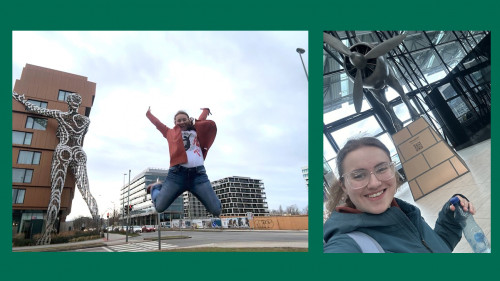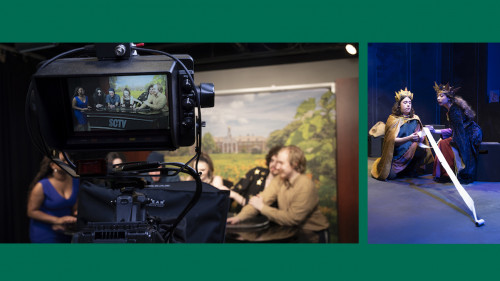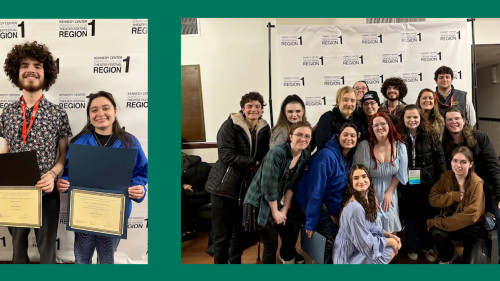
Winemaking is a science and an art, and students in the Wines of the World class pitched in at a local vineyard to find out just how much of both are involved.
The new one-credit life skills class is taught by Krysta Dennis, Ph.D., producer of creative arts, with the goal of learning to identify and appreciate good wines and the artisans who make them. For an experiential field trip, the class went to Ives Hollow Vineyard on the Upper Hudson Valley Wine Trail on October 1 to help out with the grape harvest.
The students learned about the grape varieties that are grown there, then got down to the business of harvesting La Crosse grapes right off the vines, all while being dive bombed by hornets who were attracted to the sweet juice. As a reward for their hard work, they were treated to an al fresco vineyard lunch with La Crosse wine from the previous year's vintage and PB & Js with the “J” made from their own grapes. They also had fun hanging out with Cooper, the vineyard dog.
Wines of the World does a deep dive into how grapes are grown and harvested and explores factors such as vine trellising, vineyard risk factors, soil type, and the environmental impact of grape-growing. And yes, wine tasting is involved: students are learning about and tasting wines from different wine regions of the world. Their final exam? A blind tasting.
“This is the Siena way to do things – very experiential,” said Dennis. “To really learn about wine, you need to get out in a vineyard and get dirty. We want to create educated wine consumers with the life-enriching skill of being able to identify and appreciate good wine.”
Avery Bradt ’23 is also active with the Siena College Beverage Institute, which was founded to assist the local craft beverage industry in developing marketing and promotion plans and exploring the science of fermentation. She edits video and creates graphic design for local clients and is enjoying the opportunity to learn specifically about wines.
“It’s a lot more work than I imagined,” she said, “and it’s not confined to one season. Grape growing is a year-round job. It’s been awesome to see this new, small vineyard in the very beginning stages of its operation.”
Ives Hollow had its first planting in 2018 by Kelly and Scott Michel. Scott is a full-time dairy farmer and the couple wanted to branch out into other fields of production.
“They are new to wine-growing and we felt like we were learning right along with them,” said Cate Cosgrove ’23. “Our harvest party was so fun.”
Cosgrove said before taking Dennis’ class she was “not really a wine person” but is finding the coursework a good way to explore something new.
“You don’t have to be a wine person to learn how to recognize a good wine product and appreciate how it’s made,” she said, with Bradt adding that those new to wine shouldn’t worry about being intimidated by what some see as an elitist beverage.
“You won’t know about good wines unless you try them” she said. “It’s good to be in a comfortable, non-judgmental setting where you can ask questions. You definitely won’t get laughed at.”
Dennis said another goal of the class is to “democratize and demystify” wine.
“No one should be intimidated by this,” she explained. “Knowing how to choose a good wine and how to pair it with food is a good life skill for social and business settings.”
What exactly does make a “good” wine? First, it doesn’t necessarily have to be expensive. There are a lot of delicious, well-made wines, especially those from smaller craft vineyards, that are definitely affordable even for the budget conscious. The class is learning about taste concepts such as body and balance, and how alcohol, acidity, aroma and flavor all play a role in what makes a wine stand out from the pack. There is also terroir to consider, which is the soil and conditions in which the grapes were grown, along with how they were fermented.
“Terroir is the ‘placeness’ of the wine,” said Dennis, “the journey from grape to bottle. Wine has a memory.”
Students taste five to eight different wines per class, and use a special note-taking sheet to track their impressions.
“Once you start experiencing this – oh, wow,” said Bradt. “You learn to look out for different notes of flavor such as strawberry, vanilla, coconut or minerals.”
One student said he thought the nose of one of the wines smelled like “a funeral parlor.” He wasn’t wrong: the wine they were tasting had distinct floral notes which most likely reminded him of arrangements he had smelled at a funeral.
“There are a lot of good noses in the class,” Dennis said.

